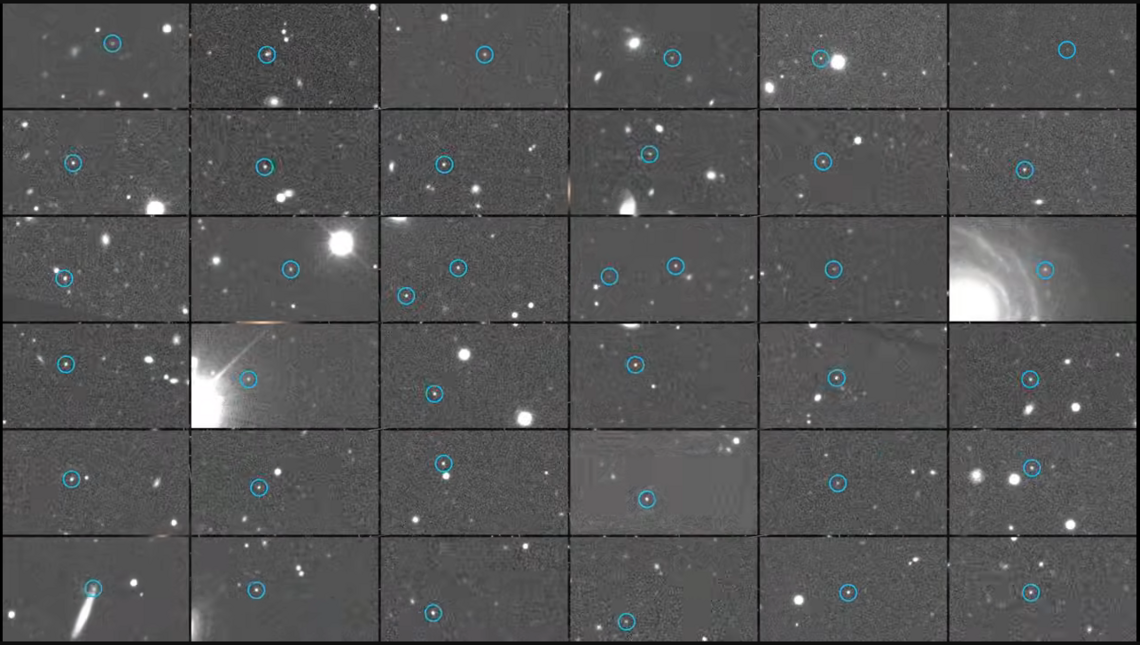Spectacular First Images from the Rubin Observatory Usher in a New Era of Cosmic Surveying and NEO Detection

June 27, 2025 – Earlier this week the Rubin C. Observatory (aka Rubin, LSST; shown above) released its first images of the cosmos to the public, and after 25 years of meticulous planning, construction, assembly and testing the wait appears to have been well worth it! One of the images shows an astonishing wide-field composite of 1185 stacked images containing numerous galaxies in the Virgo cluster. The ultra-wide field of Rubin’s images, a full 10-square degrees (about 45 full moons), coupled with the sensitive light gathering power of the telescope’s 8.4-m primary mirror and 3200-megapixel camera renders images of extraordinarily high depth, breadth, and resolution. With the release of its first sampling of images, excitement and expectations are high that Rubin will begin delivering on its promises to contribute towards our better understanding of the workings of the cosmos, and also towards planetary defense via the discovery of the Solar System’s population of near-Earth objects (NEOs). (Above image RubinObs/NOIRLab/SLAC/NSF/DOE/AURA/B.Quint)

Sample detections from the LSST’s asteroid detection pipeline indicate the survey’s potential to detect both new and known asteroids. See also: Rubin first look swarm of asteroids video (RubinObs/NOIRLab/SLAC/NSF/DOE/AURA)
The NEOs of interest are mostly asteroids whose orbits can bring them into near-Earth space, including those that might impact our planet if not discovered first and either deflected or otherwise mitigated through civil defense. Given Rubin/LSST’s observing power, the NEO surveying community was tasked to consider how big a game-changer that LSST would be for overall NEO detection, and its possible effect on global survey strategies. One of the best qualified organizations to assess Rubin’s impact is the University of Arizona-based Catalina Sky Survey (CSS). CSS has been surveying, discovering and tracking near-Earth asteroids for a quarter century and to date has discovered 16,900 near-Earth asteroids, accounting for ~44% of all known NEOs. With a rich history of NEO survey and tracking innovations, CSS recognizes that there is no ‘one-survey-fits-all’ solution from the planet-wide threat posed by asteroids. NEO surveying and planetary defense are supported by a globally coordinated and cooperative team effort, and therefore CSS are delighted to welcome Rubin/LSST into the fold.

Left to Right: Catalina’s 1-m NEO tracking telescope (I52), and 1.5-m NEO survey telescope (G96) located at 9157 feet atop Mt Lemmon in Arizona’s Santa Catalina Mountains. (D. Rankin - CSS)
Other stakeholder projects on the planetary defense team include NEO surveys such as the Panoramic Survey Telescope and Rapid Response System (Pan-STARRS) and the Asteroid Terrestrial-impact Last Alert System (ATLAS), established in 2010 and 2016 respectively. Catalina, PanSTARRS, and ATLAS are all NASA-funded projects administered under the Planetary Defense Coordination Office (PDCO), and now along with the NSF/DOE funded LSST project, will all closely collaborate to detect new near-Earth objects. However, CSS stands apart from the other surveys in that, in addition to NEO discovery they also operate telescopes dedicated to track known NEOs to better refine their orbits and rule out or otherwise help to determine possible impact threats. For many years now CSS’s 1-m follow-up telescope (I52) has submitted more NEO tracking positions than any telescope in the world, by far.
Therefore, for CSS and the other NEO surveys and experts the path forward is clear: all existing surveys are required to efficiently and effectively fulfill the 2005 George E. Brown Congressional mandate which tasks NASA to detect 90% of all near-Earth asteroids (NEAs) larger than 140-m diameter. With over 11,300 NEAs >140-m already discovered to date, estimates indicate that we are 40% to 50% of the way towards completion; and therefore, there exists thousands more lurking mid- to large-size NEAs in need of discovery. Indeed, this mandate continues to be an ‘all-hands-on-deck’ task.
Fortuitously, CSS’s location and capabilities are highly complementary to those of Rubin. As stated by Carson Fuls, director of the Catalina Sky Survey, “For planetary defense, collaboration and a layered defense is the best strategy, and Rubin adds another significant layer to our protection efforts”. Several collaborative and complimentary aspects of CSS and Rubin include the following:
- Rubin is located in the southern hemisphere in the Chilean Andes, while CSS’s telescopes are in the northern hemisphere in Arizona. While there exists some overlap of sky coverage, both projects also survey under skies unavailable to the other.
- Rubin is a general-purpose survey (i.e. surveys for all cosmic transients), whereas CSS remains singularly and technically focused on planetary defense via NEO survey and follow-up. Therefore, Catalina’s survey strategy will remain unchanged.
- CSS is currently ingesting LSST's NEO discoveries and will plan targeted follow-up observations as needed.
- CSS’s turnaround time for new discoveries is about 30 minutes while LSST's is ~2 weeks during normal survey mode. Near-real time discovery and tracking has enabled CSS to discover 6 of the 11 predicted earth-impacting asteroids since 2008, including the first 3.
- CSS are updating their NEO target broker, NEOfixer, to predict which objects will be in LSST survey fields to de-prioritize them and focus on targets that are inaccessible to LSST.
As we enter into a new era of NEO surveying, welcoming Rubin into the effort, CSS looks forward to continued fruitful cooperation and collaborations with all NEO surveys and tracking observatories around the planet. We remain always as dedicated watchers of the skies, and as our project motto proclaims, in the service of the global public - Hic Servare Diem - “Here to Save the Day”.
The Catalina Sky Survey is based at the Lunar and Planetary Laboratory in the University of Arizona’s Planetary Science Department. CSS is a NASA funded project whose dedicated mission is to discover and track near-Earth objects.



